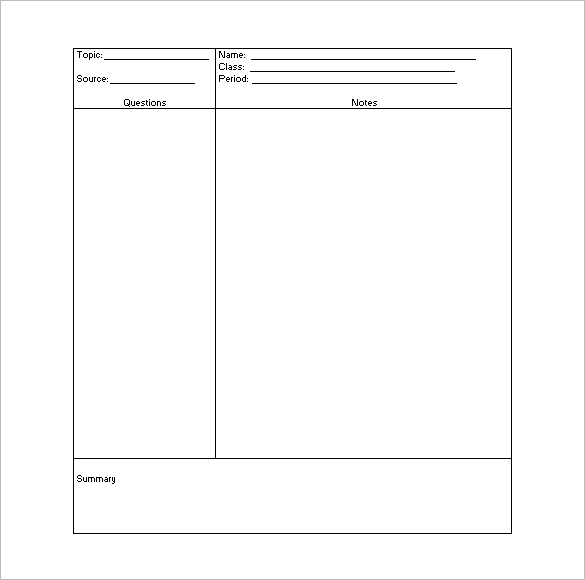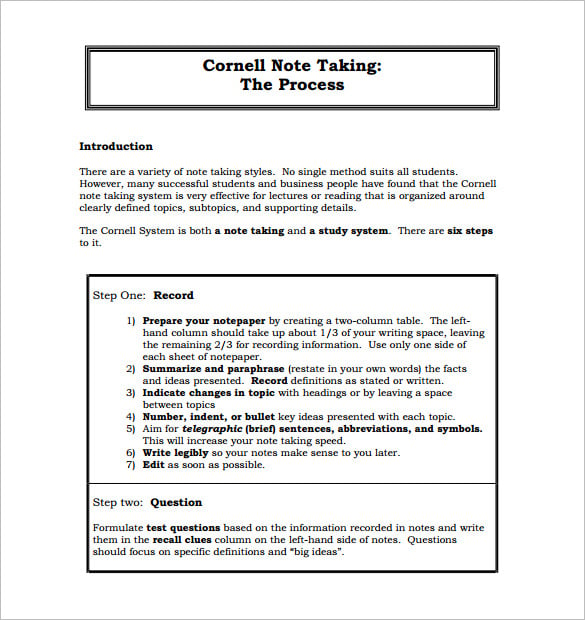Cornell Note Taking Method Custom Pdf Generator Free
This semester I have been facilitating breakout groups for the learning strategies course in my faculty. Last week, the session focused on reading and note-taking.
One of the activities had the students make a Cornell note on a section of the course’s textbook. Download bleach manga torrent. When I asked if any of them had heard of Cornell notes before, 0 of 19 hands went up. The Cornell note-taking system is a widely-used notetaking system devised in the 1950s by Walter Pauk, an education professor at Cornell University. Pauk advocated its use in his best-selling How to Study in College, but its use has spread most rapidly in the past decade. Despite a lack of familiarity with the method, all the students intuitively grasped the concepts of notes, cues, and summaries. Whether or not they integrate it into future notes remains to be seen. Instead of rehashing the volumes of information available (348,000 Google results), here are my favourite Cornell note resources: BLABLA (includes the best explanation of the system I’ve found and an example note) (for students who take notes with a computer, scroll to the bottom of the page to download the template) Did you know about Cornell notes before this post?
Do you use them? Why or why not? Let us know in the comments.

I first heard of it in college thirty-odd years ago. The professor who explained it to us was in favor of typing paper because it was cheap, and I objected that I wanted lines to keep my writing from slanting downhill and I wanted holes to keep my notes in a binder, and I already indexed my notes in the space at the top of the page so why should I change what I was doing? I did start using the margins more. He did not appreciate my response to his enthusiasm, but he was too nice a guy to be really annoyed with me.
Contents. Overview of method The Cornell method provides a systematic format for condensing and organizing notes. The student divides the paper into two columns: the note-taking column (usually on the right) is twice the size of the questions/key word column (on the left). The student should leave five to seven lines, or about two in (5 cm), at the bottom of the page. Notes from a lecture or teaching are written in the note-taking column; notes usually consist of the main ideas of the text or lecture, and long ideas are paraphrased.
Long sentences are avoided; symbols or abbreviations are used instead. To assist with future reviews, relevant questions (which should be recorded as soon as possible so that the lecture and questions will be fresh in the student's mind) or key words are written in the key word column. These notes can be taken from any source of information, such as fiction books, DVDs, lectures, text books, etc. Within 24 hours of taking the notes, the student must revise and write questions and then write a brief summary in the bottom five to seven lines of the page. This helps to increase understanding of the topic. When studying for either a test or quiz, the student has a concise but detailed and relevant record of previous classes.
Cornell Method Of Note Taking

When reviewing the material, the student can cover the note-taking (right) column while attempting to answer the questions/keywords in the key word or cue (left) column. The student is encouraged to reflect on the material and review the notes regularly. Studies on effectiveness A study published in 2010 by Wichita State University compared two note taking methods in a secondary English classroom, and found that Cornell Note taking may be of added benefit in cases where students are required to synthesize and apply learned knowledge, while the appeared to be better for basic recall. Cornell format is one of the most frequently suggested note taking format by university websites for student support. However, Cornell notes might be less effective than taking regular notes for certain subjects. Another study published in the summer of 2013 found that 'Students who were taught CN (Cornell notes) did take better notes than those who were not, but they did not have higher achievement results.' The study also stated that 'Through analysis of assessment scores, I found no significant difference between the intervention and base classes on achievement.'

See also. References. Herr, Norman; Joens, Ross J. (2008) 1962, The Sourcebook for Teaching Science, Grades 6-12: Strategies, Activities, and Instructional Resources (10 ed.), Cengage Learning,. Becoming A Lawyer. Retrieved 2017-03-18. Wong, Linda (2014-01-01).
Cengage Learning. Jacobs, Keil. Proceedings: 4th Annual Symposium: Graduate Research and Scholarly Projects 79 Conference proceedings held at the Eugene Hughes Metropolitan Complex, Wichita State University, April 25, 2008.
Symposium Chair: David M. Eichhorn. Becoming A Lawyer.
Retrieved 2017-03-18. Broe, Duane (Summer 2013). Retrieved 2017-05-12. External link in website= External links Wikibooks has a book on the topic of:.